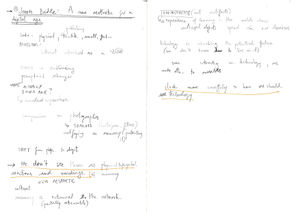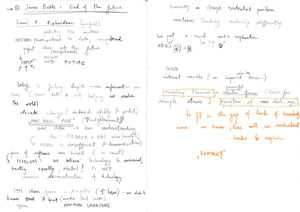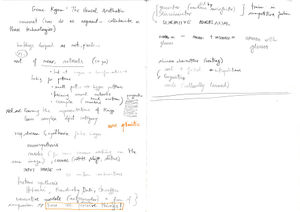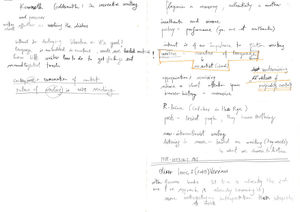Mia/Synopsis, annotation, notes and argument
part 1: few examples: listen, take notes, sum up the thesis and conclusion
James Bridle: A New Aesthetic We do not see technology as a physical and psychological encoding of memory and experiences, but this is indeed what technology is. We need to look more carefully to how we should use technology.
James Bridle: End of the Future The more information we have, the harder it is for us to understand how the world works. Therefore, we desire for conspiracy theories to fill the gap of our lack of understanding, providing explanation in a form of simple narrative. They are symptoms
Gene Kogen: The Neural Aesthetic The ways technological devices encode and interpret information are similar to how we as human beings perceive things. Therefore, the collaboration between man and technology is possible but also fruitful.
Kenneth Goldsmith: On Uncreative Writing Writers are curators of language just as a curator in contemporary art works as an artist himself. This should be understood in a broad sense, which undermines the notions of originality and creativity.
part 2: the text of our choice
Susan Sontag: On Photography, chapter Photographic Evangels
Whether photography is defined as art can be explored through its comparison with painting. On one hand, photography was claimed to be painting’s ‘’mortal enemy’’ since it radically encroached on the way artists and viewers perceived painting but also its subject matter and the way of depicting it. On the other hand, it was claimed to be its liberator because it overtook its task of faithful representation. But unlike it is generally believed, painting did not directly turn to abstraction, but rather adopted the camera’s eye – the way an image-maker sees (preference for the fragment, interest in humble life, effects of light etc.). The experience of looking at the painting can help us to decode better the photographs. Yet regarding our experience of painting, photography has weakened it. One of the examples is photographic reproduction that heavily affects the perception of paintings (and other artworks). However, photography and painting are not two competitive systems for (re)producing images, but are two mediums of different order.
There are two ideas about art: first meaning an activity of exceptional individuals producing valuable objects and the second one claiming the art being obsolete. Hereby, photography confirms both points of view. In discussion whether photography is art, two answers seem to appear. On one hand, photography produces works that can be called art, however, it is not an art form itself. In fact, photography is a medium – just as language for instance – in which works of art are made, but unlike painting and poetry, it is not art in itself. It is capable of acting as a faithful recording as well as being an artist’s true expression. Nevertheless, it has a capacity to turn all its subjects into works of art.




